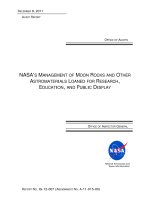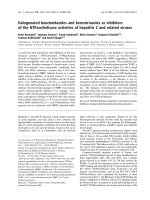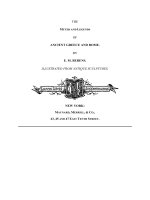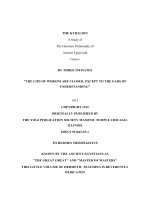Rembrandt's Reading: The Artist's Bookshelf of Ancient Poetry and History
Bạn đang xem bản rút gọn của tài liệu. Xem và tải ngay bản đầy đủ của tài liệu tại đây (8.44 MB, 292 trang )
a msterdam university press
amy golahny
rembrandt’s
reading
The Artist’s Bookshelf of
Ancient Poetry and History
a msterdam university press
Rembrandt’s
reading
Amy golahny
lthough rembrandt’s study of
the Bible has long been recognized as intense, his
interest in secular literature has been relatively
neglected. Yet Philips Angel (1641) praised
Rembrandt for “diligently seeking out the knowledge of histo-
ries from old musty books.” Amy Golahny elaborates on this
observation, reconstructing Rembrandt's library on the evi-
dence of the 1656 inventory and discerning anew how Rem-
brandt’s reading of histories contributed to his creative pro-
cess. Golahny places Rembrandt in the learned vernacular cul-
ture of seventeenth-century Holland and shows the painter to
have been a pragmatic reader whose attention to historical
texts strengthened his early rivalry with Rubens for visual
drama and narrative erudition.
Amy Golahny has written numerous articles on and around Rem-
brandt, and edited a book on the reciprocity of poetry and painting,
The Eye of the Poet (1996).
She earned her doctorate at Columbia
University, and is professor of art
history at Lycoming College,
Williamsport, Pennsylvania.
www.aup.nl
A
isbn 90 5356 609 0
9 789053 566091
rembrandt’s reading
amy golahny
rembrandt’s
reading
The Artist’s Bookshelf of
Ancient Poetry and History
amsterdam university press
The publication of this book is made possible by a grant from the
Prins Bernhard Cultuurfonds and the Historians of Netherlandish Art.
Cover design and lay out Kok Korpershoek, Amsterdam
Cover illustration Rembrandt, Artemisia,1634.
isbn 90 5356 609 0
nur 640
© Amsterdam University Press, Amsterdam, 2003
All rights reserved. Without limiting the rights under copyright reserved above, no part of
this book may be reproduced, stored in or introduced into a retrieval system, or transmitted,
in any form or by any means (electronic, mechanical, photocopying, recording or otherwise)
without the written permission of both the copyright owner and the author of the book.
9 Acknowledgments
13 preface
The Scope of the Study
chapter 1
17 Book Culture
19 The Image of the Reader in Rembrandt’s Art
24 Rembrandt as Rag-picker and Book-hunter?
25 The Ubiquitous Book
29 The Humanist Library and its Organization
34 The Process of Reading
36 Reading to Illustrate:
Rembrandt’s Ship of Fortune and Medea
42 Observations on Literary Theory and Painting
46 Rembrandt’s Judas
chapter 2
49
Rembrandt’s Training
51 Academic Studies
59 Rembrandt’s Apprenticeship to Jacob van Swanenburgh
64 Pieter Lastman: Pedantic Literacy
72 Rembrandt’s Scholarly Acquaintances
5
table of contents
chapter 3
75
Rembrandt‘s Bookshelf Part i
77 The 1656 Inventory and its 22 Books in the Breestraat House
81 Callot’s Gants Jerusalem
88 Dürer’s proportie boeck
chapter 4
97
Rembrandt’s Bookshelf Part iI
“15 books in various sizes”
99 Rembrandt’s Proserpina: Visual Rhetoric from
Claudian and Scaliger
105 Amorous Myths from Ovid
114 Reading Homer: Vulcan’s Net
122 The Historical Homer: Poet and Teacher
129 Artemisia: Devotion in Body and Soul
chapter 5
135
Rembrandt’s Bookshelf Part iII
German Folios
138 A Confrontation: Popilius Laenas and Antiochus
147 Livy as a Studio Resource: Lucretia, Scipio, Dido
164 Stimmer’s Josephus
chapter 6
181 Rembrandt’s Later Imagery
After the 1656 Inventory
184 The Amsterdam Town Hall
187 The Oath of Civilis
191 A Case of Kindness: Pyrrhus
199 Defying Mortality: Zeuxis Laughing
6 rembrandt
’
s reading
chapter 7
207 Artists’ libraries
Practicality and Universality
218 Avoiding Error: Advice to the Artist
230 An Essential Reading List
237 Rembrandt’s Library Concluded
243 notes
262 bibliography
275 Illustration Acknowledgments
278 index
table of contents 7
My interest in Rembrandt’s reading was prompted by Arnold Hou-
braken’s seemingly contradictory statements that artists ought not to
“bury their noses in books,” yet ought to know histories well. After all,
the craft of painting demanded expertise in the practice of art, not in
the study of texts. I wondered how little Rembrandt needed to read in
order to draw, paint, and etch his subjects from ancient poetry and his-
tory. In May 1996, I began to develop a limited reading list for Rem-
brandt. I have been fortunate to conduct research at the Houghton
Library of Harvard University, the Butler and Avery Libraries of
Columbia University, the New York Public Library, The Special
Collections of The Pennsylvania State University Library, Biblioteca
Nazionale Firenze, Universiteitsbibliotheek Amsterdam, Koninklijke
Bibliotheek, Plantin-Moretus Museum, Rijksbureau voor Kunst-
historische Documentatie, Rijksprentenkabinet, The British Library,
University of Michigan, The Warburg Institute, Bibliothèque Natio-
nale, Fondation Custodia, Louvre, Musée des Beaux-Arts de Rennes,
Herzog August Bibliothek, Herzog Anton Ulrich Museum, Berlin
Kupferstichkabinett, and the Staatliche Graphischesammlung, Munich.
The staffs of these libraries and museums generously and patiently
filled my requests. At Lycoming College, Tasha Cooper, Rose Di-
Rocco, Cathleen Hurwitz, Georgia Laudenslager, Marlene Neece, and
Gail Spencer provided invaluable support with interlibrary loans and
many other queries.
This project was greatly aided by funding from several sources.
In 1996, the National Endowment for the Humanities facilitated my
9
acknowledgments
research in a summer seminar at Harvard University; in 1999, the
Deutscher Akademischer Austauschdienst funded research in Ger-
many; and Lycoming College provided generous and sustained support
in five summer grants and a sabbatical year. The Prins Bernhard Cul-
tuurfonds made the publication possible by a grant. The Historians of
Netherlandish Art supported publication costs with its award of 2002.
In the course of researching and completing this study, I re-
ceived the good will and assistance of many who shared expertise and
answered inquiries, in correspondence and in conversation: Michiel
Roscam Abbing, Jeremy Bangs and Thomasine Flynn, Kit Basquin,
Kristin L. Belkin, Jill Bepler, Melanie Blake, Alan Chong, Nina Cich-
ocki, Paul Crenshaw, Anthony Cutler, Patrick Daum, Stephanie
Dickey, Juana Djelal, Thomas Döring, Wayne Franits, Luba Freed-
man, Anne Halpern, Susan K. Harris, Ed de Heer, J. R. Judson, Jan
Kelch, George Keyes, Jill Kraye, Charlotte Loeb and the late Arthur
Loeb, Anne-Marie Logan, Volker Manuth, Elizabeth McGrath, Law-
rence Nichols, Lida Ouwehand, Shelley Perlove, John F. Piper, Jr.,
Frances L. Preston, Johanna C. Prins, Michael Rinehart, Bert van den
Roemer, Anne C. Rose, Gary and Loekie Schwartz, Anne-Charlotte
Steland, Sandra Stelts, Gerhard Strasser, Carola Vermeeren, Richard
Wendorf, Mariët Westermann, Ernst van de Wetering, Thea Vignau-
Wilberg, and Michael Zell.
I am deeply grateful to Bas Dudok van Heel for many discus-
sions on the fine points of Rembrandt documentation with me, and to
the late Julius Held, for his keen interest in this project from its incep-
tion. Martin Royalton-Kisch and Paul Taylor shared cogent observa-
tions on Rembrandt’s drawing of Pyrrhus. Charles Lutcavage and Anna
E. C. Simoni graciously clarified the linguistic closeness of Dutch
and
German during the Renaissance. Eric Jan Sluijter and Lisa Vergara
read portions of this material in early phases, and J. Michael Montias
read the manuscript in a later stage; they offered many helpful sugges-
tions that contributed much to this study. I am indebted to
Christian
Tümpel, whose scholarship has broken new ground for Rem
brandt
studies, for his insightful discussions and kindness. For singular gen-
erosity of advice and lively conversation, Egbert Haverkamp Bege-
10 rembrandt
’
s reading
mann is an unequalled friend and mentor. The scholarly exchanges
that I have enjoyed over the years with him have contributed immea-
surably to my research and my understanding of Rembrandt as a cre-
ative artist. Suzanne Bogman, Anniek Meinders, Chantal Nicolaes, and
Marike Schipper of the Amsterdam University Press expertly guided
this project from manuscript to publication. My gratitude to friends
who offered hospitality and insight extends warmly to Sarah Falla and
Paul Jefferson, Anne-Marie and Daniel Haber, Fermin and Philip
Rocker, and Nicolette Sluijter Seijffert. Finally, I thank my family for
their patient interest and support of this project. My warmest appreci-
ation
goes to Fred, Berta, Yuda, Irene, Richard
, Emily and Gabe.
note to the reader
All translations are my own, unless otherwise noted; transcriptions
keep to their original, often archaic, text. Pagination in early imprints
differs among editions. Catalogue references for Rembrandt drawings,
prints and paintings are provided in cases where the work is not illus-
trated, or in cases where a reference was considered important.
acknowledgments 11
This study addresses the question: What did Rembrandt read in order
to create his subjects from ancient poetry and history? That question
prompted two more: could there be established a somewhat limited
reading list for this artist? How does Rembrandt’s reading contribute
to his art? The following chapters provide answers to the first ques-
tion, and responses to the next two: a limited reading list may be ascer-
tained, but reading alone hardly accounts for Rembrandt’s conception,
invention, execution, and interpretation of his historical themes. Rem-
brandt’s greatness lies in his mastery of illusion in the service of narra-
tive; it involves how he represented his themes as much as what they
are. Rembrandt developed the stylistic means, in paint, pen, and print,
to craft illusions of the material world and to communicate subtleties
of expression; he developed a style that dazzled the beholder with tech-
nical skill and conveyed psychological complexities.
Rembrandt’s reading list in ancient poetry and history would
connect him to the general literate culture of his time, even if it is in-
sufficient to account for his art. This study does not include the Dutch
literature of emblems, theater, costume books and poetry; nor does it
concern the Bible, dramatic productions, and artist manuals. Rem-
brandt was surely familiar with, if not expert in, this material. By exam-
ining Rembrandt’s reading in ancient poetry and history, we gain one
measure of the intellectual context of his time and his works, and we
step closer to an understanding of how he visualized stories of human
activity, emotional response, and moral associations.
13
preface
The Scope of the Study
Publications serve as known and often identifiable quantities in the
measuring of knowledge available to Rembrandt. His acquaintances in
Leiden, Amsterdam, and The Hague were literate if not erudite, and
many were poets and scholars. A few of these had substantial libraries
and art collections, to which Rembrandt may have had access. But his
conversations with his acquaintances and chance encounters with oth-
ers remain unknown quantities, even if we can trace some connections
and speculate about their exchanges. Among the more notable of Rem-
brandt’s works that depend more upon verbal exchanges than textual
comprehension is the series of four etchings made for Menasseh ben
Israel’s La Piedra Gloriosa. From studying the changes in the prints, we
understand that the artist collaborated closely with the author in mak-
ing his imagery conform to the demands of the text. By accounting for
the more certain relationship between Rembrandt and the printed text,
we can also speculate more precisely about those aspects in Rem-
brandt’s oeuvre outside its influence, and then indicate where friend-
ship and ephemeral contacts may have contributed. The evidence
gathered here is dependent upon print culture, and the analyses take
into account Rembrandt’s milieu, biographical circumstances, and con-
tacts. My purpose has been to demonstrate what was commonly avail-
able and to recreate concisely the literary material that fueled Rem-
brandt’s image-making process in his narrative secular themes.
Two approaches are blended here to reconstruct Rembrandt’s
reading. One is based on his paintings, drawings, and prints, and pro-
ceeds from the works themselves that depend upon poetic or historical
texts. The other is documentary, and examines the 1656 inventory of
Rembrandt’s possessions in order to discuss named titles and to sug-
gest several more that he may have owned. I suggest these additional
titles on the evidence in Rembrandt’s own work; I discuss the historical
subjects in a roughly chronological order, with the 1656 inventory as a
convenient division between the earlier and later works.
Beyond the scope of this study are single figure compositions,
allegorical imagery, and portraits, which often carry allusions to pub-
lished sources, and surely reflect the parameters of reading knowledge
14 rembrandt
’
s reading
similar to Rembrandt’s narratives. The puzzling 1626 History Paint-
ing, too, is a work I leave for another project.
Chapter 1 reviews the status of reading and literary theory in the
Netherlands during the seventeenth century. The Dutch had the high-
est literacy rate in Europe during this time; their production of books
was a major industry. The educational process at the highest level was
the humanist emphasis on ancient literature and theory as the founda-
tion for all learning; within the popular culture, the same process was
diluted and accessible in the vernacular. Rembrandt belonged to a fairly
specific humanist culture.
Chapter 2 surveys Rembrandt’s education and training. Latin
school, which Rembrandt attended for at least several years, usually led
to further study and a career in law, medicine, or theology. However,
it was not unusual for artists to receive a good education. Rembrandt’s
two teachers, Jacob van Swanenburgh and Pieter Lastman, were well
read; several of Rembrandt’s pupils attended Latin school. Finally,
Rembrandt’s academic training would have prepared him to converse
with his acquaintances and patrons, of whom the two most learned
were Constantijn Huygens and Jan Six.
Chapter 3 analyzes how the 1656 inventory lists Rembrandt’s
books. The inventory is a record of his possessions at that time, and in-
cludes 22 books. This document is only a guide to the possessions of
the artist, who had already sold some of his print collection. Nonethe-
less, it is a worthwhile starting-point for reconstructing his “library.”
Two books in it were illustrated by Callot and Dürer, and kept among
the folios of prints and drawings; these two books may have been valued
as much for their illustrations as for their words. The rest of the books
were kept together in a small room, much like a closet, in which vari-
ous paraphernalia, collectibles, coins, and small statues were also kept.
Chapter 4 examines the mythological and historical subjects
painted or drawn by Rembrandt during the 1630s and later. The texts
that served these images were probably small books, without illustra-
tions. The resultant works demonstrate how the artist read one or more
passages in a text, or even more than one text, in order to formulate
preface 15
unique images. These books were not obscure titles, but rather, the
mythologies in the vernacular and two brief Latin passages in the
works of well-known classical authors who were not translated into
Dutch.
Chapter 5 focuses on three folio histories that are grouped to-
gether in the inventory. One of these, Josephus with Stimmer wood-
cuts, is an established source for Rembrandt. Two others can be sug-
gested: Livy and a historical compendium. These may have served as
teaching tools in the studio. These three folios, probably all in Ger-
man, may have been useful for both text and illustration.
Chapter 6 concerns the later historical subjects by Rembrandt
that depend upon textual accounts in Tacitus, Plutarch, and other
writers. After the 1656 inventory and sales of his possessions, Rem-
brandt continued to collect art works; presumably, he also picked up a
few books and other paraphernalia useful in his profession.
Chapter 7 compares the library of Rembrandt to libraries of
other artists of his time. His lifetime reading must have exceeded the
nearly two dozen books that appear in the 1656 inventory. However,
22 books would have been sufficient to support his profession as a his-
tory painter. After dispensing practical observations, writers on art
most often repeated this advice to the artist: know the histories well, in
order to avoid error. That Rembrandt did so is evident in his work.
16 rembrandt
’
s reading
chapter 1
book culture
fig. 1 – Rembrandt, Cornelis Claes Anslo. Etching, 1641
The Image of the Reader in Rembrandt’s Art
embrandt’s own attitude to reading
may be illuminated by his many portrayals of readers. His
portraits of men often include books to give tangible signs
of the sitter’s profession, as preacher, accountant, or
author. When the book is a Bible, it carries meaning invested in the
divine word. The act of interpreting the divine word is a dynamic
process; it involves the person portrayed and the viewer. In Rem-
brandt’s portraits of the Mennonite preacher and merchant Cornelis
Claes Anslo, the prominent books are as significant as the figures. In
the 1641 etching, Anslo sits at a table; upon the table are the tools of
his task as interpreter of the word: four books, an inkwell, and a pen
case [fig. 1]. He holds the pen in one hand, which rests upon a closed
book standing on its spine, and he gestures to an open folio, itself rest-
ing upon two more volumes. Open-mouthed as if speaking, he looks
off to the side, addressing an unseen audience. His reading involves the
immediate consultation of two volumes, and the reference of two
more. He takes notes, as if to emphasize that his process of reading re-
lates directly to his writing and preaching. Thus Anslo compares several
texts and communicates his interpretation of them. Anslo’s method of
reading by comparing passages in several volumes was standard prac-
tice for cross-referencing, in theology, history, law, and literature. The
act of reading involves a process of absorption, cogitation, and expres-
sion; the act then affects the beholder – himself the listener.
book culture 19
r
Rembrandt’s grand double portrait of Anslo and his wife, also of 1641,
makes an even stronger connection between the divine word and the
active roles of interpreter and listener [fig. 2]. A large Bible, opened to
show the source of Anslo’s wisdom and authority, carries as much pic-
torial weight as either of the sitters. The Bible rests upon a wooden
lectern, and another smaller volume lies nearby; a bookshelf, half-cur-
tained, holds volumes of various sizes. The books, as well as the carpet
and cloth covering on the table and the attentive spouse, amplify the
character, scholarship, wealth, social position, and morality of the
Mennonite preacher and cloth dealer.
1
20 rembrandt
’
s reading
fig. 2 – Rembrandt, The Mennonite Preacher Cornelis Claes Anslo and his
Wife Aeltje Gerritsdr. Schouten, 1641
Vondel wrote a short poem about Rembrandt’s portrayal of Anslo; this
famous quatrain becomes the intermediary between the sitter and
viewer:
2
O Rembrandt, paint Cornelis’ voice,
His visible parts are the least of him.
The invisible is perceived through the ears alone.
He who would see Anslo must hear him.
Vondel’s exhortation to the beholder to “hear” the voice of Anslo is an
emphatic, appropriate response: the image conveys only part of the
message of the man. A challenge to the artist, Vondel’s poem was well
within the critical response not only of the rivalry between painting
and poetry, but also of the expectations of portraiture. Rembrandt’s
lively portrayals of Anslo meet the challenge that an image must con-
vey the full presence of the sitter: the image must be both seen and
“heard” – that is, it evokes in the viewer the imagined voice of the de-
picted person.
3
Essential to interpreting scripture, Anslo’s reading is a
public act, one that demands an audience.
Rembrandt also portrayed the act of reading as a solitary pas-
time; in his etched portrait of Jan Six of 1647, Rembrandt presented
reading as an introverted activity [fig. 3]. The preparatory sketches
demonstrate how Rembrandt first drew an extroverted Six, with his
dog jumping against his leg.
4
Only in developing this portrait did
Rembrandt arrive at the wholly inward mood of this seriously quiet
image. Every aspect of the final composition reflects the literary and
artistic interests. Even the light, as paper tone untouched by ink, is a
refined participant; it is the “open” space of the window, and the agent
by which Six reads. This light illuminates the head and hand of Six, the
sword hilt upon the table, and the pile of books, the top one opened,
on a bench in the left corner. Here, as in many other works by Rem-
brandt, the books are extensions of the sitter’s character, and light, as
symbolic and natural illuminator, reveals these possessions with the
modulations so essential to Rembrandt’s art.
5
book culture 21
fig. 3 – Rembrandt, Jan Six in his Study. Etching, 1647
However compellingly Rembrandt portrayed reading – either as an act
of interpreting divine word or as a solitary pastime – he never shows
himself engaged in it. He presented himself as an elegant gentleman, a
costumed warrior, or a practicing artist. In the singular case in which
Rembrandt portrayed himself with an artifact of writing and reading,
he took on the identity of the Apostle Paul. In the 1661 Self-Portrait as
St. Paul, Rembrandt shows himself with manuscript and sword, which
are Paul’s major attributes: the letter to the Ephesians that is a fore-
most interpretation of the Christian faith and the sword that is the
agent of Paul’s martyrdom.
6
Rembrandt’s identification with Paul may
be understood on several levels. Rembrandt’s long-standing fascination
with the apostle and his teaching is evident from among his earliest
works.
7
He may have taken on Paul’s role as interpreter of Christian
salvation by faith as an analogy to the artist’s own role of
visual inter-
preter of the Bible. After all, Rembrandt’s emphasis through
out his
work was on the Old and New Testaments, and often on those themes
that concerned miracles and tests of faith. Significantly, Rembrandt
adopts the creative and active message of Paul as author of the epistle,
thereby underscoring the parallel between apostolic writer and creative
artist.
Books are otherwise conspicuous by their absence in Rembrandt’s
self-portraits. The absence of books is an extraordinary circumstance
in comparison to the works by some artists close to Rembrandt. Gerard
Dou, Rembrandt’s first pupil, consistently demonstrated his own learn-
edness in self-portraits that proclaimed the unity of practice and theory
by including art materials and books. According to Dou, the artist de-
rived knowledge and status from booklearning. And indeed, depictions
of scholars, hermits, saints and others with books are prevalent in
the works of Dou and other artists associated with Rembrandt. These
depictions inextricably link scholarship and spirituality.
8
Rembrandt,
however, seems to proclaim in his art that the act of painting was supe-
rior to its sources, both pictorial and textual. Although Rembrandt cer-
tainly benefitted and used the information he gained from publica-
tions, he most often chose to suppress their display in his presentation
of himself.
book culture 23
Rembrandt as Rag-picker and Book-hunter?
Rembrandt’s passion was for art collecting, rather than book-hunting.
He bought prints and drawings at auction, and acquired costumes,
weapons, and exotic items at the Amsterdam markets. His art collec-
tion was kept alongside the miscellany of useful paraphernalia in his
house, according to the 1656 inventory.
9
His habit of acquiring old
clothes and tools was noted by several early writers. Filippo Baldinucci,
whose biography of Rembrandt was published in 1686, wrote:
10
He often went to public sales by auction, and acquired clothes
that were old-fashioned and shabby ; he hung these on the
walls of his studio among the beautiful curiosities which he also
took pleasure in possessing, such as every kind of old and mod-
ern arms, arrows, halberds, daggers, sabres, knives, and so on
These clothes and armaments indeed appear in Rembrandt’s work as
exotic costumes. According to Roger de Piles, Rembrandt had a quan-
tity of “old weaponry, instruments, old head-coverings, and a great
deal of old embroidered fabrics,” which he called his “antiquities.”
11
De Piles mocked these things as antiques. He considered Rembrandt
ignorant of ancient art and classical precepts. On the other hand, Rem-
brandt himself may have been ironic when regarding his old rags as
valuable antiquities. Rembrandt may have been a “pack-rat” who pick-
ed up what he liked and what he could use in his work. His browsing
through the auctions and markets would have been a habit. Andries
Pels reported:
12
He searched avidly through the entire city, on its bridges and in
corners, in the New and North Markets, for weaponry, hel-
mets, Japanese daggers, fabrics, and rags, which he found pic-
turesque, and often he passed a Scipio with a Roman physique,
or one with the noble bearing of a Cyrus.
24 rembrandt
’
s reading









